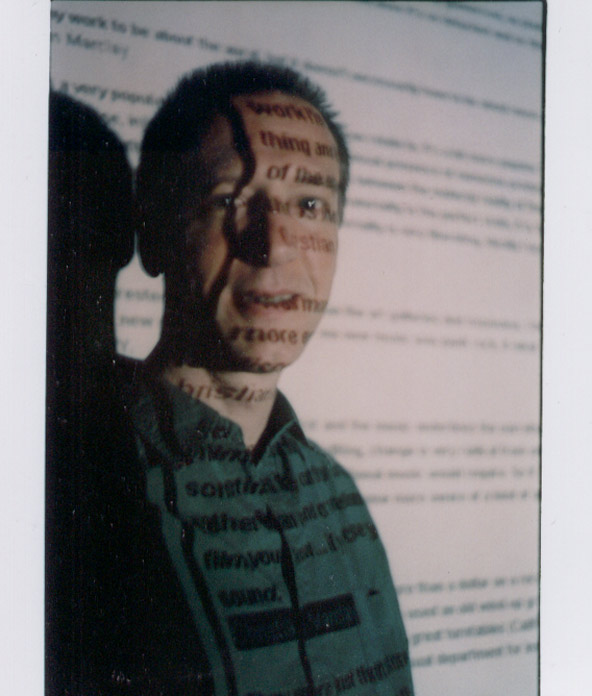
Venerdì sera – 18.06.04—The seeing ear/L’orecchio vedente

Tematica:
1. Su questo Venerdì
2. Su Christian Marclay
3. Sul suo lavoro
link:
http://www.mcachicago.org/cm_media/run-index.htm
http://www.furious.com/perfect/christianmarclay.htm
http://www.16beavergroup.org/intorno
___________________________________________________
1. Su questo Venerdì
Cosa: The seeing ear
Quando: 6:30 pm, Venerdì 18 Giugno, 2004
Dove: LaT, Laboratorio Tolentini presso la sede dello IUAV, Santa Croce 191
Chi: tutti sono invitati
Incontreremo Christian Marclay
insieme a Veniero Rizzardi (Docente di
Musica Elettronica e Radio regia presso il Dipartimento di Storia delle
Arti e Conservazione dei Beni Artistici).
___________________________________________________
2. Su Christian Marclay
New York based artist Christian
Marclay works in a variety of disciplines
including music, performance, and visual art. He is pioneering
turntablist, whose recordings and collaborations with Sonic Youth, Elliott
Sharp, and Otomo Yoshihide, among others, have had a definitive impact on
the avant-garde music scene over the last twenty years. Marclay’s
sculptural and video installations turn our attention to the process of
hearing and seeing music. For example, Marclay has rendered “impossible
instruments”, such as a drumkit that towers from floor to ceiling, its
parts positioned according to their respective pitches in a visual
representation of the sounds they make. For Prosthesis (2000), he made
silicone rubber cast of an electric bass guitar. Marclay’s altered
instruments continue his exploration of situating music and performance in
the gallery. “It may seem like a contradiction, but I’m interested
in
sound, not just for how it sounds, but also for how it looks”, Marclay
has
said. Whether manipulating vinyl records in his performances or rendering
sculptures from mute instruments, he continually refers to music as
intersections between the audio and the visual, blurring the distinction
between these two mediums.
Il lavoro di Christian Marclay
attraversa diverse discipline: musica,
performance ed arti visive. Pionieristico Turntablist, le cui
registrazioni e collaborazioni con Sonic Youth, Elliott Sharp, e Otomo
Yoshihide, tra gli altri, hanno avuto un impatto decisivo sulla scena
musicale d’avanguardia degli ultimi vent’anni. Le installazioni
di
sculture e video di Marclay spostano la nostra attenzione verso il
processo audio-visivo. Per esempio, Marclay ha realizzato “strumenti
impossibili”, come una batteria che si eleva dal pavimento al soffitto,
le
cui parti sono disposte secondo le loro rispettive tonalità in una
rappresentazione visiva del suono che producono. Per Prosthesis (2000), ha
realizzato il calco in gomma siliconica di un basso elettrico. Gli
strumenti alterati di Marclay continuano la sua esplorazione nel situare
musica e performance nello spazio della galleria.
“Può sembrare una contraddizione, ma sono interessato al suono,
non solo
per come suona, ma anche per come appare”, dice Marclay. Manipolando
dischi nelle sue performance o realizzando sculture di strumenti muti,
egli si riferisce continuamente alla musica come intersezione fra audio e
video, sfocando la distinzione fra i due medium.
___________________________________________________
3. Sul suo lavoro
Christian Marclay’s
work has been seen widely in major international group
exhibitions including Doubletake: Collective Memory and Current Art,
Hayward Gallery (1991), Synesthesia: Sound and Vision in Contemporary Art,
San Antonio Museum of Art in Texas (1994), the Venice Biennale (1995),
Crossings, Kunsthalle Wien (1998), d’APERtuto, the Venice Biennale (1999)
and Notorius, Alfred Hitchcock and Contemporary Art, Museum of Modern Art,
Oxford (1999).
Solo exhibitions have included
The clocktower, PS1, New York (1987), the
Hirshhorn Museum and Sculpture Garden, Washington (1990), Pictures at an
Exhbition, Whitney Museum of American Art at Phillip Morris, New York
(1997), and a recent residence at the Art Pace Foundation for Contemporary
Art in San Antonio, Texas.
He has performed widely,
has released several solo and compilation
recordings, and has collaborated on recordings with John Zorn, David Moss,
Fred Frith, Elliott Sharp, Günter Müller and Sonic Youth, among many
others.
Il lavoro di Christian Marclay è stato ampiamente esposto nelle più
importanti collettive internazionali, come: Doubletake: Collective Memory
and Current Art, Hayward Gallery (1991), Synesthesia: Sound and Vision in
Contemporary Art, San Antonio Museum of Art in Texas (1994), La Biennale
d’arte di Venezia (1995), Crossings, Kunsthalle Wien (1998), d’APERtuto,
La Biennale d’arte di Venezia (1999) and Notorius, Alfred Hitchcock and
Contemporary Art, Museum of Modern Art, Oxford (1999).
Le sue Personali includono:
The clocktower, PS1, New York (1987), the
Hirshhorn Museum and Sculpture Garden, Washington (1990), Pictures at an
Exhbition, Whitney Museum of American Art at Phillip Morris, New York
(1997), ed una recente residenza alla Art Pace Foundation for Contemporary
Art a San Antonio, Texas.
Si è ampiamente esibito,
ha pubblicato diversi dischi come solista e in
raccolte, ha collaborato con John Zorn, David Moss, Fred Frith, Elliott
Sharp, Günter Müller e Sonic Youth, e molti e altri.